Whirling Witchcraft is a brand new game from AEG games, and is a colourful mix of engine building, card drafting, variable player powers, and simultaneous actions.
Publisher: AEG
Designer: Eric Andersson Sundén
Artist: Weberson Santiago
Release date: 2021
2-5 Players
Age: 12+
30 mins
Favouritefoe score: 7.5/10
* Engine Building * Card Drafting* Pattern Matching * Simultaneous Action * Asymmetric Player Powers *
Whirling Witchcraft has been brewing up a storm on Instagram and Facebook over the past few weeks. Granted, its theme was spot on for the Halloween-y time of year, which whipped up excitement in every corner or every coven. Question is; will you hanker after its Hubbly Bubblyness long after the pumpkins and broomsticks have been put away?
Witches’ Brew!
Well, to answer that question, you need to know what Whirling Witchcraft is and what it does.
So, here, you are witches combining ingredients listed on spell cards. Cast your spell over a neighbouring opponent, and you’ll be sending them spiders, mushrooms, and other nasties in an effort to overload that Wiccan’s workbench.
If there’s no space for any of the ingredients you send them, they bounce back to your own witch’s circle. Collect 5 ingredients back from your ne-er do well neighbour, and you’re the winner!
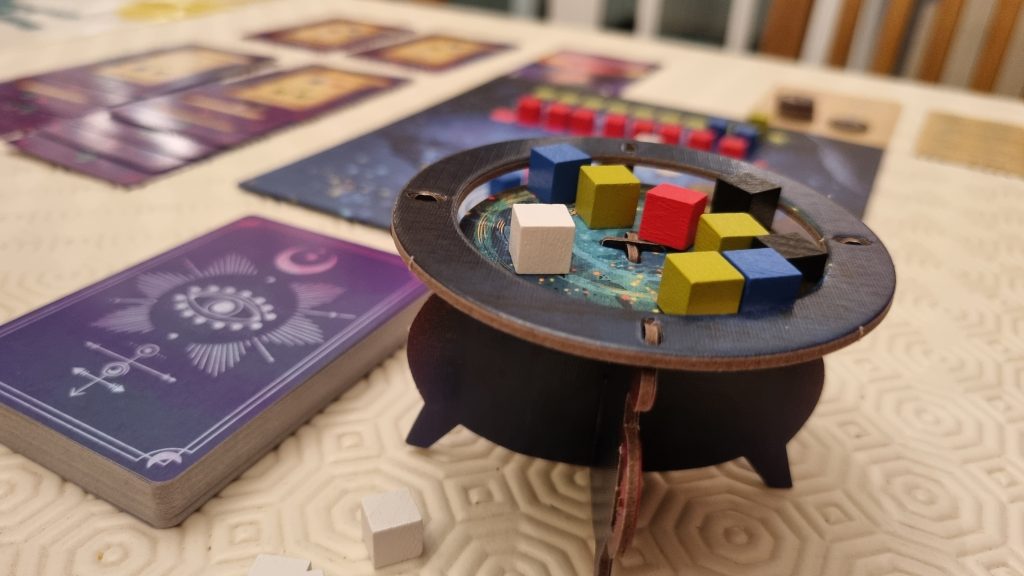
Setting Up Your Spells!
So what do you need to do to get those impish ingredients?
Well, everybody needs an (asymmetric) personality card, a cauldron, a workbench board, a hand of four spell cards, and a bonus arcana card with matching tokens. Your personality card is extra important as it will determine your starting ingredients, as well as your special power for the game. There is a basic Initiate personality which you can use in your first game, but you’ll quickly want the powers of the Potion Brewer and Whirlwind for sure!
Once you’re all set up, you simultaneously decide which spells you can incant, and staring mixing up magic!
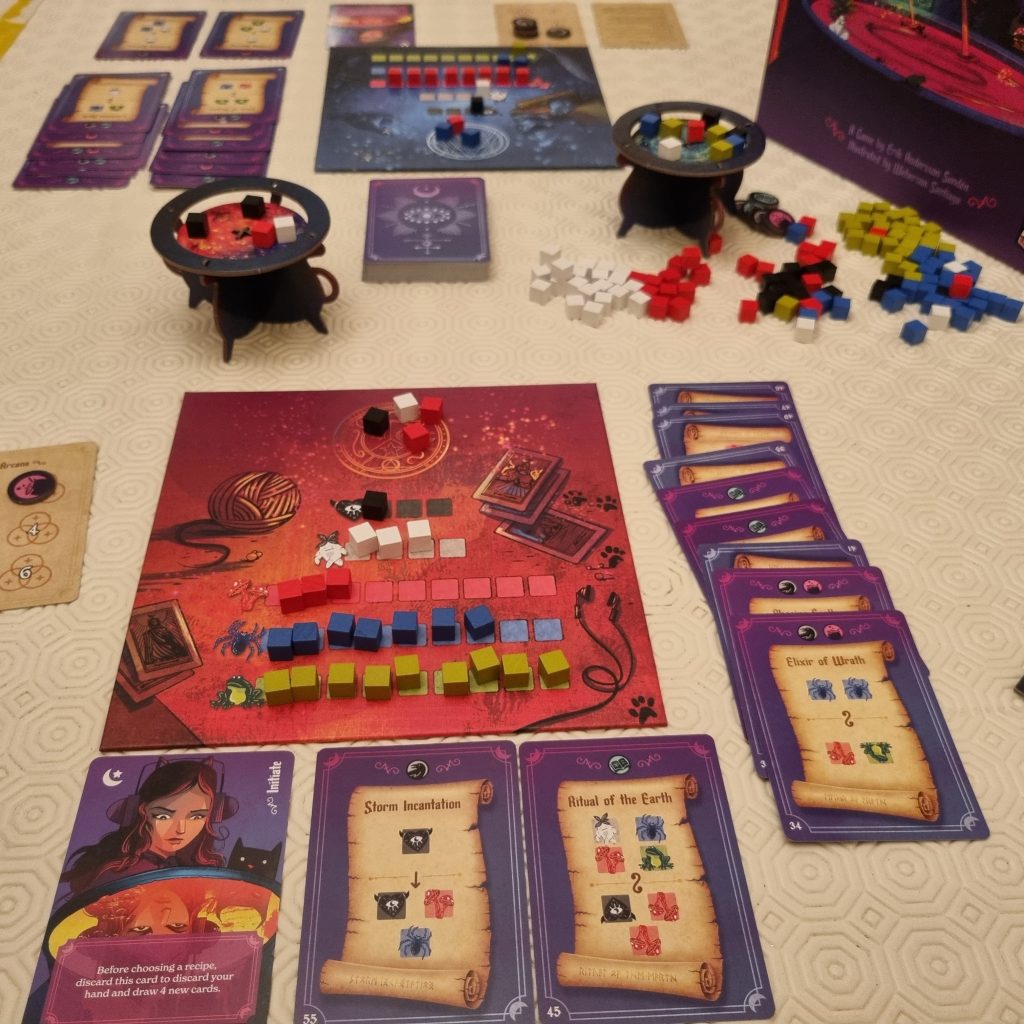
Can You Spell?
Spellcasting is a combination of inputs and outputs. If you can add the necessary ingredient cubes from your workbench to the input section of your spell card, then you can add cubes from the general supply to the output section. Those output ingredients then go into your cauldron ready to be sent to the player immediately seated on your right. Once they receive them, they must add them to the corresponding ingredient sections of their workbench. The input ingredients you have on your spell cards then go back into to the general supply.

Arcana Spell that!
I mentioned above that you are given 3 arcana tokens and an arcana tracker card at the start. These can be incredibly useful bonus powers. And that is because, if you cast a spell with any arcana symbols on it throughout the game, you get to move the pictured token one space along your arcana track. Once a token reaches an even number, you can use it to manipulate the ingredients. And meddle you may in one of three ways:-
- The Raven lets you remove two ingredients from your own workbench and put them back into the general supply;
- The book lets you take one type of ingredient from the general supply, and use as many of those type as you need to fill the input section of your played spell cards; and
- The cauldron lets you add an extra ingredient from the general supply to your cauldron ready to be sent off to your neighbouring witch.

Get Set Spell!
So, this game is actually broken down into two phases;
- Study Phase:
Each round, you pick a recipe card from your hand of four – even if you don’t have the necessary ingredients to make it. Once everyone has studied, these are revealed simultaneously and placed next to any spells you played in previous rounds. If there are any arcana symbols on your card, move the corresponding token along on your tracker card. If it hits an even number, you can trigger its bonus power now.
2. Brewing Phase:
Then it’s cooking time! Place the input ingredients for your spell cards and fill up the output sections from the general supply. Once done, scoop up the output cubes and pop them in your cauldron.
Pass your cauldron to the player on your right. They must add all those cubes onto the matching spaces on their own workbench board. From the cauldron you receive, you must place the cubes on the corresponding rows on your own workbench board.
If you receive more of one ingredient than there is space for, it gets placed in the witch’s circle of the player who gave it to you. As soon as any player has 5 ingredients in their circle, the game is over and that player is the Winning Witch! If nobody reaches the fearsome 5, you pass all remaining recipe cards in your hand to the player on your left. Everyone refills their hand up to 4 cards, and a new round begins.
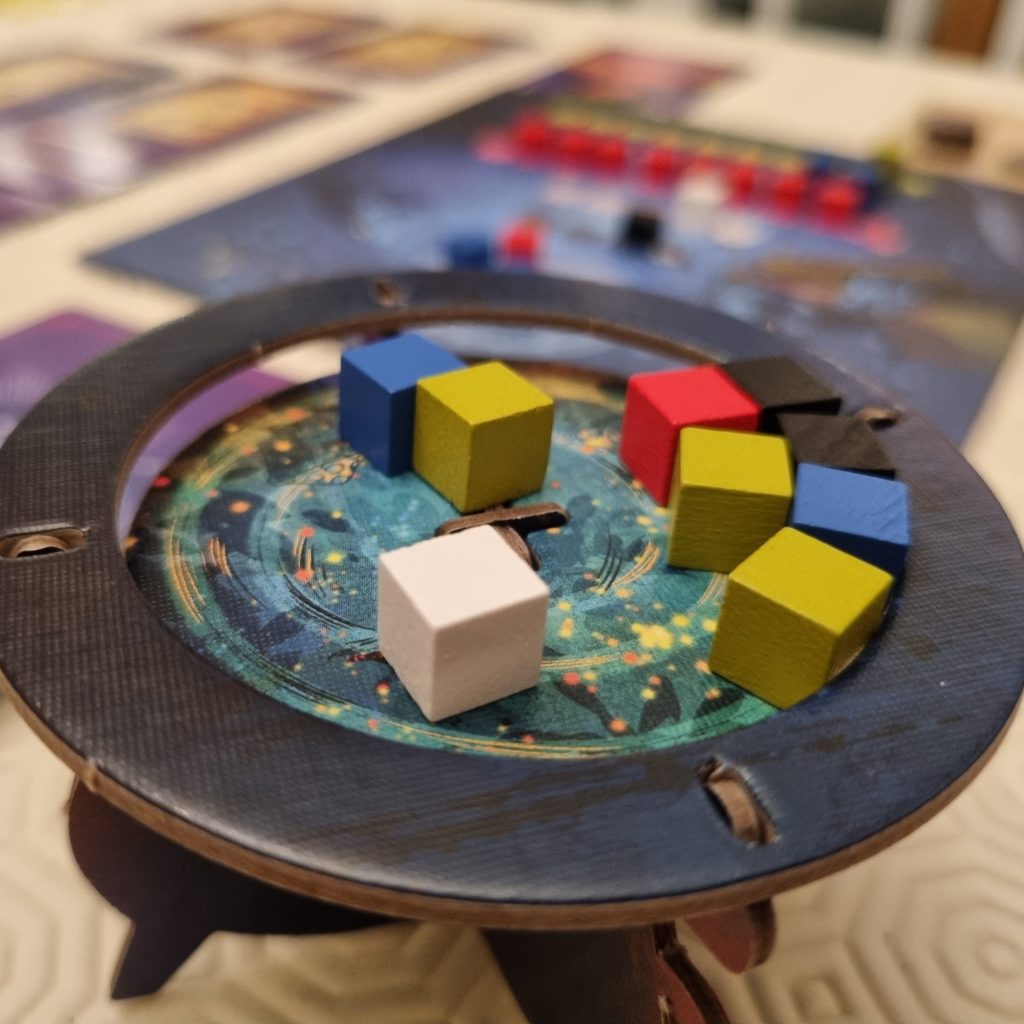
Cute but Calculating Cauldrons!
First off, I can’t wait any longer, and there’s no denying it; the cardboard cauldrons look so cool! A bit fiddly to handle if you’re passing them back and forth. And in fact, in a 2 player game, we just position ours centrally for easier filling and emptying. But, they look super on the table, and definitely help to enhance the theme of the game. Dropping coloured cubes onto the swirling top, and then watching them get emptied by your opponent (who really wished they didn’t have to!), is verrryyy satisfying!
But where is the engine in this magical dash to overwhelm witchy workbenches? Well, it’s a little different, but it’s there. You need to get ingredients in order to make ingredients in order to send those off to your neighbour. Don’t forget, board busting is what this game is all about.
It’s a strange and beguiling twist on the usual resource management mechanic for sure. Rather than revving up to get more stuff to covert into more points by selling or stockpiling, here you really want to make stuff in order to give it away!
And how do you keep making the ingredients you need? Well, the ongoing spellcasting steam power mainly comes from your previously filled recipes. Those little ripe and ready resource pools, combined with ingredients currently on your own board, will help you get the ingredients you need to mix up your new spell as well as any you want to use from previous rounds. And what do ingredients make? Oh yes, cauldrons full to the brim with gruesome goodies! Mushrooms and frogs and spiders that you send off to the player on your right!
Filling your cauldron with handfuls of cubes for the sending comes from knowing which spell to cast, and when to cast it. You effectively want to combo your active cards (along with your asymmetric personality power) so that they churn out enough cubes to fill the input sections. Do this right and bundles of board breaking outputs will tumble into your cauldron to be despatched. But, you must remember that inputs can also be taken from your workbench. And this will often be important too. After all, you need to constantly clear enough space to reduce the risk of ingredient overload.
Chaining spells, powers, and your own resources in order to make a frog factory or a spider shop is therefore really where the fuel is firing in this game.
And obviously, as this is ultimately a race, filling up your opponent’s workbenches must happen faster than they can pile up cubes on yours!
Arcana acts a little like a Nitrous Oxide hit to your existing engine. For example, with a book activated, you can grab a type of ingredient from the pool rather than your own workbench. If you have run out of something you need to make spells (or to fill up the inputs on previous spells), then (thanks to the arcana hit) you can go ahead and grab them from the pool, fill up, and fire off spells like a demented demon!
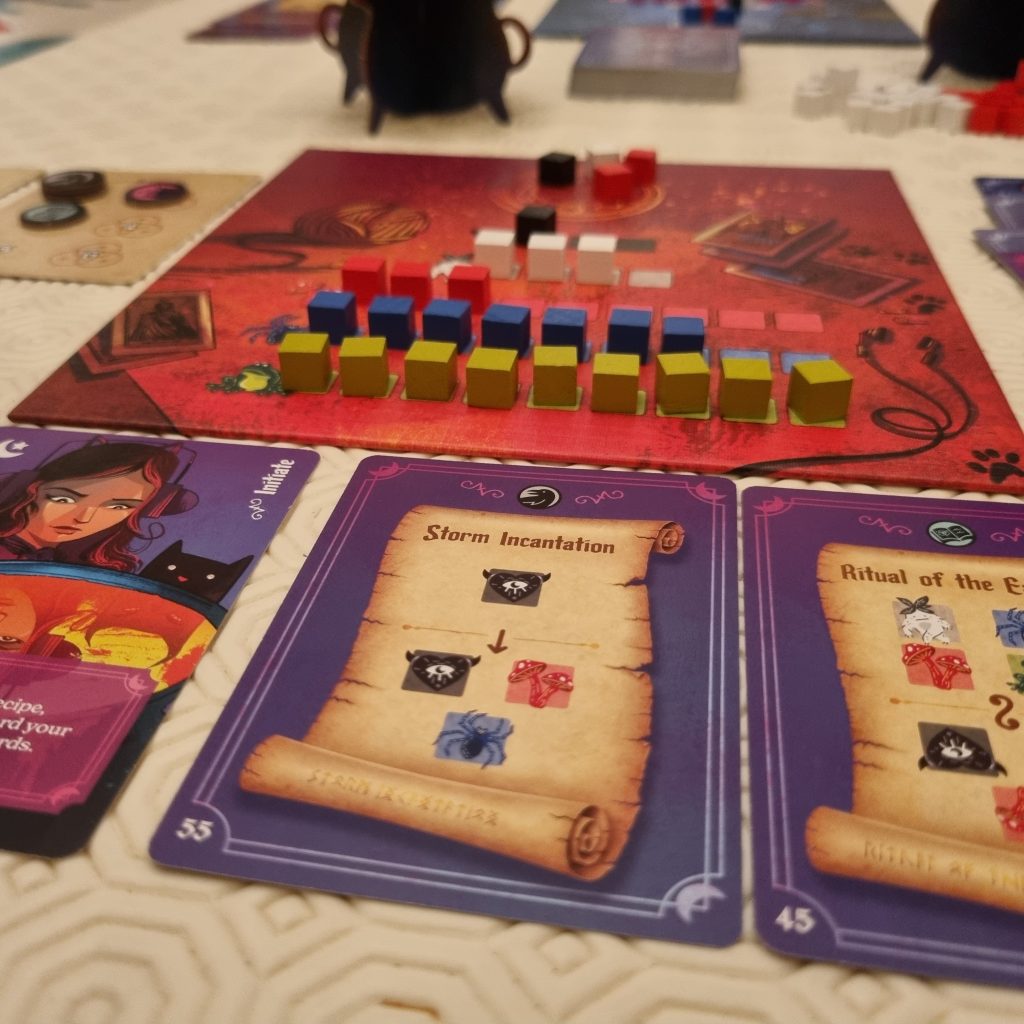
Boiling up a Balance!
You need cubes, but not too many. You want arcana bonus powers, but again not too many (you snooze, you lose on that front!). The space you have for the ingredients you need (and potentially don’t want!) might also be wide open one turn but tight the next. With room for only 3 black Hearts of Shadow, compared to 9 mushrooms, any spell pushing you over the black cube capacity is going to be a quick way to fill up your witch’s circle……or so you might think…..
But here is where balance really comes into effect. If you can keep at least one eye on what the player to your right is doing, you might be able to push them over the edge on a few resources. Select spells that target outputs of those resource type and they’ll be drowning in mandrake faster than they can lose it. Keep pouring them onto their board every round, and your successful engine is likely to win you the game.
But, you also need to keep an eye on the spells they incant (which could turn their weakness into a strength to fight their own opponent), as well as what is heading your way. Knowing what you are likely to get (as everyone’s spells are open information) can help manage your board – after all, you know what is going to be coming in and therefore what you need to shift in order to make room. And sometimes that can help; giving you ingredients you know you can then cause havoc for the player on your right. Sometimes the generosity just spills over, however, and you end up filling an opponent’s witch’s circle instead.
Lucky Lizard Tails?
You won’t always have good spells (although their names are super and we do find ourselves saying them in boomy voices as we play them!), which can hurt if you’re not a fan of chance. Especially if a lucky or unlucky card draw is the difference between winning and losing towards the end of the game. Having the chance to mitigate using arcana bonus powers, as well as your special ability in the game, is helpful, but it isn’t always enough/
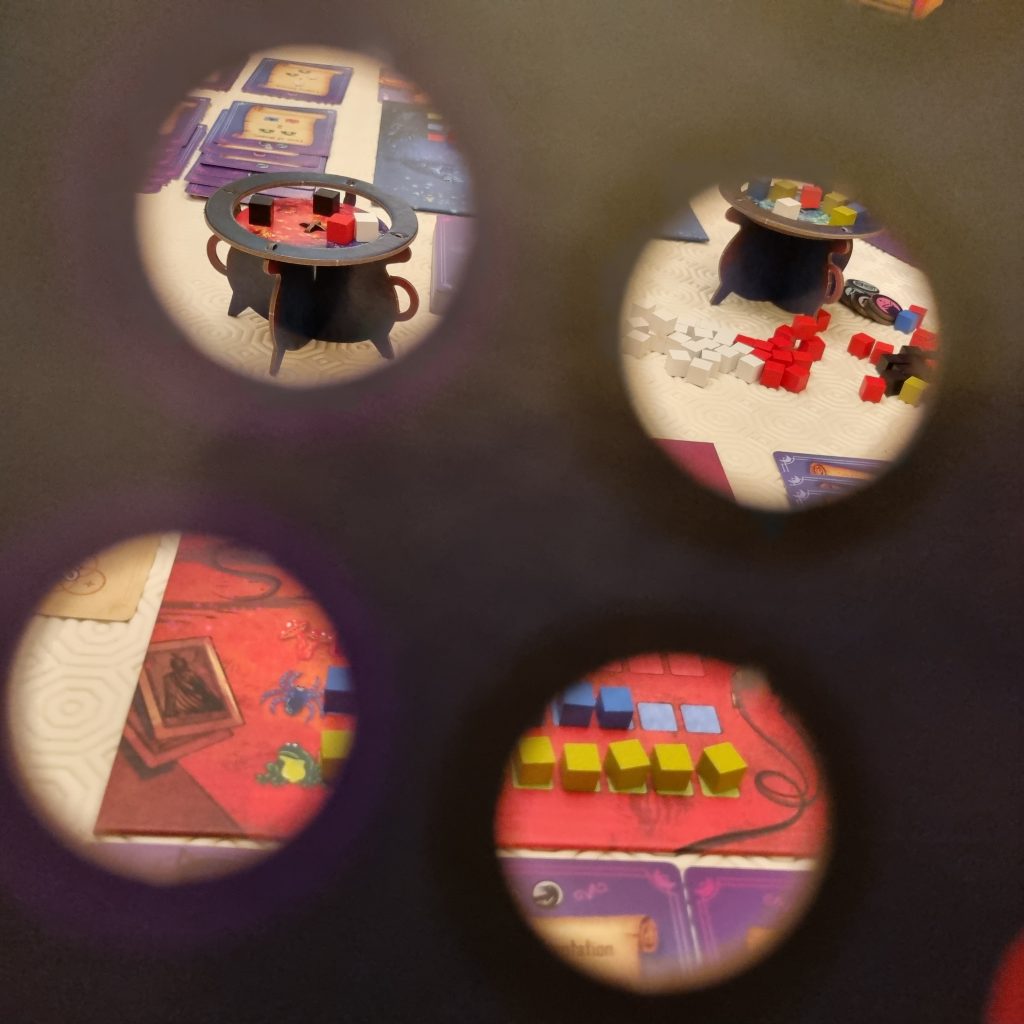
Fast Froggies and Speedy Spiders!
Ultimately, for us, we find the more cauldrons bubbling, and the faster they are filling, the more fun this game is to play. Watching a cauldron head your way filled to the brim with cubes knowing that you haven’t been able to offload enough to make space for them, is like watching a toddler trip in slow motion! You know it’s coming. You can’t do anything to stop it, but that won’t reduce the crushing blow (or the laughs afterwards)! We have played at 2 player, and it plays just fine. But the card swapping and cauldron filling has more colourful sparks at higher player counts. And strangely, this is true even though the person you take ingredients from, and the one you give them to, stays the same regardless of player count.
I suppose the difference could be that there are more chances to get ahead if you drop behind in a 3, 4, or 5 player game. With other players directly affecting their own neighbours, you might profit from another meta brewing battle going down elsewhere in the main game.
Simultaneous play also means that turnover of cubes is quick, which is good as it doesn’t really allow for the bitter taste of ingredient overload to last that long in your mouth. It’s quickly back to fun filling and busting again. You’ll be rattling through spells, dropping cubes, and generally too busy trying to overwhelm each other’s workbenches in a race to be the winning witch to dwell on a previous round for too long.

Component Cooldown?
I must say that we find the ingredient cubes a little small, and they tend to slide around the workbench boards and on the shiny cards quite a lot. A dual layered board that stops the cubes sliding around at least on the workbenches would have been excellent. The rule book is also a little bit confusing. For a game that is actually very simple to play – I would certainly recommend this to new-ish gamers looking for an engine builder that is quick and entertaining but also not just the norm- the rules did make us think we had underestimated the gameplay. We hadn’t – it was as bright and breezy as we had predicted. But the rules were a little unclear in places. We also wish the arcana tracker wasn’t on the back of the player aid, because if we needed to check something (or even the arcana symbol meanings themselves), we either have to remove the arcana tokens (and then remember where they went), or look in the heftier rule book (which takes time and negates the purpose of the player aid!)
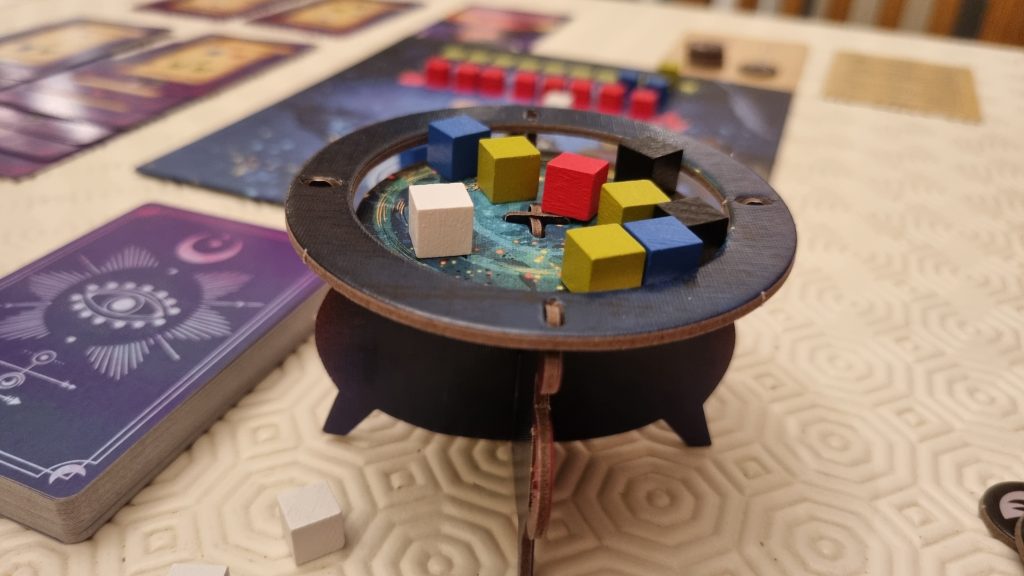
Winning Witches?
Notwithstanding some gripes over the components and the rule book front, this debut game from designer Eric Andersson Sundén is really quite innovative, and definitely takes engine building somewhere different!
Bearing in mind the fixed nature of the movements in this game, I think it would be fun to give ingredients to, and get ingredients from, different players. Perhaps by players taking it in turns to be the Wild Witch who nominates each other’s froggy foe for that round. It could mix up strategies and effect the special abilities (some of which do feel more powerful than others), and even help break a runaway lead from a particularly efficient engine. But I guess that could affect the duration and a specific balance that the designer has worked to achieve.
Overall, Whirling Witchcraft is a light, fast, colourful filler game. For us, the real enjoyment, however, definitely shines brighter at higher player counts. Unusual really, as we are usually 100% in favour of mean take-thatiness and sharp strategy employed directly to wipe the floor with just each other. But, whether it is the bright, colourful setting of the game, or because it has kooky cauldrons that bring smiles to players’ faces when they get to use them, it just feels more fun when there is a bigger group of people fighting for workspace wickedness!

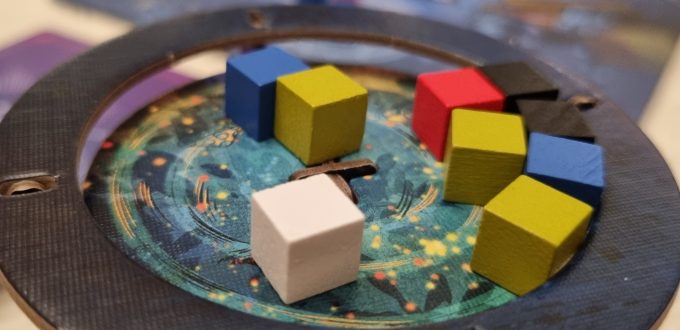
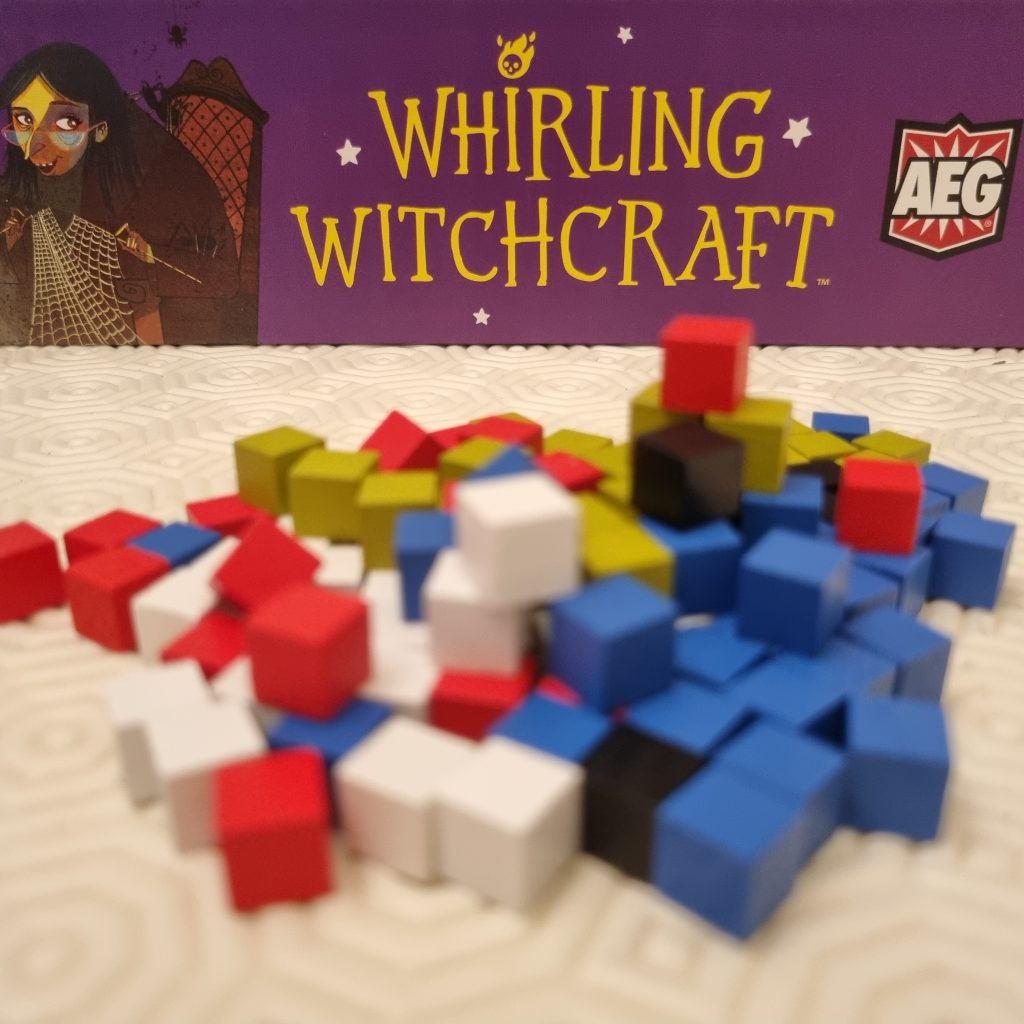

No Comments Yet